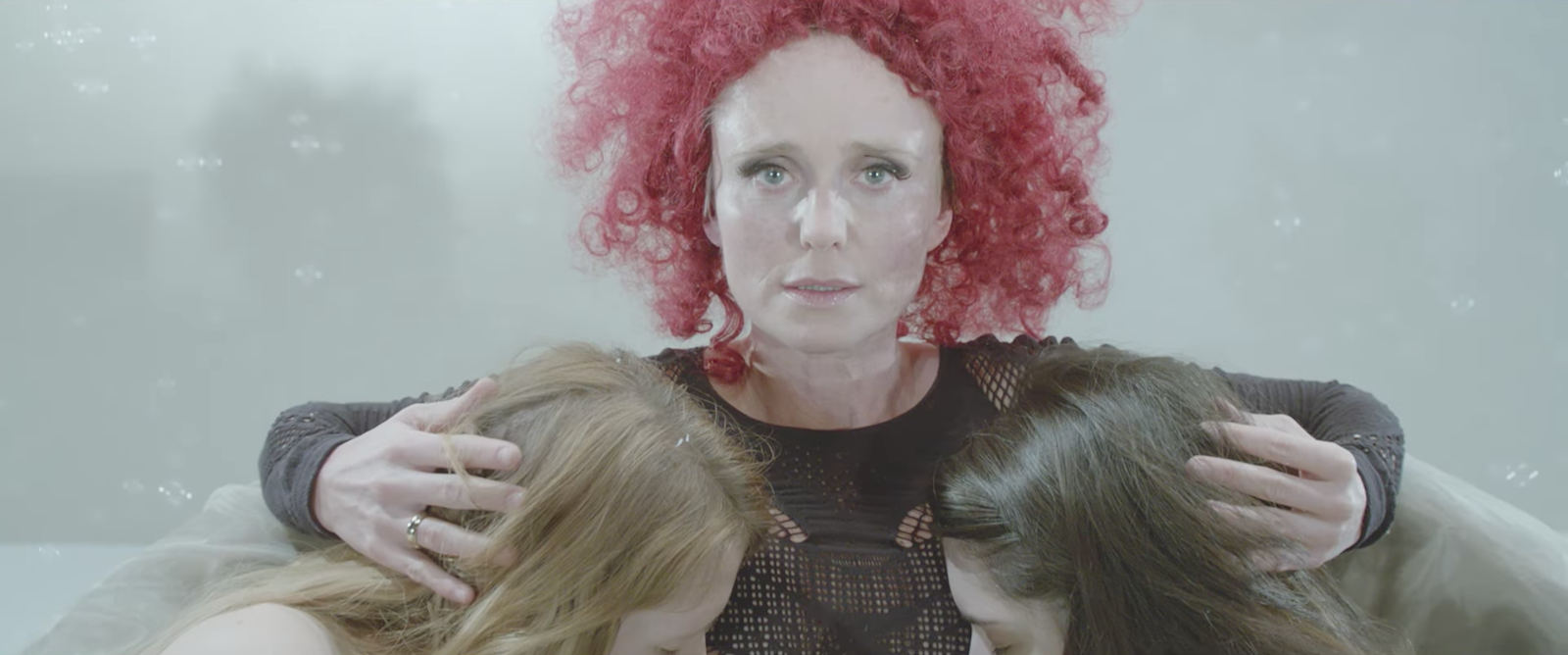One hundred percent.
[Note: This post contains spoilers.}
Twin Peaks: The Return // Part 16 // Original Air Date August 27, 2017 // Written by Mark Frost and David Lynch // Directed by David Lynch
It was a long time coming. The Lodge entity MIKE (Al Strobel) gives distorted, matter-of-fact expression to the thrill that Twin Peaks devotees likely feel when Dale Cooper’s (Kyle MacLachlan) eyes snap open in Part 16 of The Return, “You are awake. Finally.” Significantly, it isn’t Cooper-as-Dougie that sits up in a Las Vegas hospital bed, but the genuine article, the earnest FBI agent who immediately begins rattling off commands to everyone around him, albeit in that agreeably decisive way that compels listeners to leap to their feet and follow his directions. Dale Cooper is back, after 25 years in Black Lodge purgatory and some 13 episodes of exile in the metaphorical wilderness of suburban banality and gangland peril. Even Mark Frost and David Lynch, despite all their artistic nerve, can’t resist the hokey fanservice twinkle of Cooper announcing, as though directly to the audience, “I am the FBI.” Hell yes.
The old Dale Cooper’s return is a sequence of unabashed elation, but also one that feels wholly earned. At times, it’s been admittedly frustrating that the Coop viewers knew and loved has effectively been absent for the first 15 episodes of The Return. However, as his awakening in Part 16 illustrates, sometimes absence indeed makes the heart grow fonder. The long slog back to full cognizance makes the sudden return that much sweeter, and the attendant sense of a looming Cooper vs. Mr. C face-off that much more exhilarating. The viewer is no longer anxious for Cooper’s safety as they were when he was fumbling about in his Dougie haze, perilously vulnerable to manipulators and murderers. The FBI agent’s spry self-assurance hasn’t faded in the least, and seeing it in action once again gives one hope that the stony, ruthless Mr. C might have a worthy opponent at last. (Now it’s a boxing match!)
If there’s an immediate bittersweet element to Cooper’s awakening, it’s the unfortunate implications for Janey-E (Naomi Watts) and Sonny-Jim Jones (Pierce Gagnon), who are suddenly without a husband and father. The real Dougie Jones is, of course, long dead—or, a bit more accurately, recycled. However, as expressed through the muffled personality of Dale Cooper, “Dougie” changed the lives of the Joneses for the better, and not just with the jackpot-winning assistance of the Lodge. Indeed, while shuffling his way through Dougie’s life, Cooper has improbably acted as a spiritual good luck charm, giving second chances and opportunities for nobility to everyone he touches, from the endlessly appreciative Mitchum brothers (Jim Belushi and Robert Knepper) to the newly remorseful Anthony Sinclair. (Everyone except Ike the Spike, perhaps, but Las Vegas is certainly better off without him.)
When Cooper earnestly confides to his alter ego’s family that, “You have made my hearts so full,” he’s not humoring them in the least. He recognizes that, though “manufactured,” Dougie Jones was granted a little slice of everyday heaven (a home, family, and steady job), only to squander it by being a dishonest, good-for-nothing creep. Coop has spent enough time with Janey-E and Sonny-Jim to discern that they deserved better than a cheating, dissolute tulpa. Perhaps not all is lost, however. Cooper’s gift of a tuft of his own hair and his directive to MIKE to “make another one,” could be part of his endgame with Mr. C, but they alternatively could be his final gift to the Joneses, in the form of yet another Dougie.
Part 16’s other major story turn occurs when Diane (Laura Dern) finally reveals her true allegiances to her erstwhile FBI allies. This double-cross is not as central to the plot as Cooper’s return to consciousness, and it hasn’t been simmering for nearly as long, but it’s nonetheless a development that astute viewers likely saw coming. When Diane receives an opaque, weirdly menacing text from Mr. C, ":-) ALL," it seems to trigger a Manchurian Candidate-style programming, compelling her to text back the coordinates she’s memorized and to then put a permanent end to the meddling of Gordon (David Lynch), Albert (Miguel Ferrer), and Tammy (Chrysta Bell) with the snub-nosed revolver in her purse. (Just in case there were any lingering question as to where her loyalty lies, Lynch reprises the freakishly slowed-down “American Woman” from Part 1 while Diane nervously approaches Gordon’s hotel room.)
Naturally, Diane fails to get the drop on the FBI agents, because they have been onto her from the beginning, but the key revelation that emerges from her betrayal is that she isn’t Diane at all, but another tulpa. Although, in fine Diane fashion, once she is returned to the Lodge, she does spit a final “fuck you” at MIKE before disintegrating into black smoke. Her artificial nature does raise an obvious question: Where is the real Diane? The tulpa offers a hint before she draws her revolver and vanishes, repeating dreamily, “I’m in the sheriff’s station.” (As shrewd viewers have pointed out, only one letter distinguishes “Naido” from “Diane.”)
Given the gob-smacking drama of "Diane's" treachery and corporeal dissolution (!), it’s all too easy to overlook what is perhaps the most meaningful detail in her final confrontation with the FBI agents. Her flustered, shuddering description of her traumatic encounter with Mr. C many years ago is colored by the same sense of panicked de-realization that characterizes Audrey Horne’s plight. “I’m not me!” Diane cries over and over, creating a feedback loop of overwhelming dread. This sort of dissociative confusion is a recurring (and escalating) motif in The Return. In fact, one might assert that the dominant mood of the new series is an awareness that something is not quite right (or downright horribly wrong) about otherwise familiar people, places, and situations. Like one’s own home as experienced in a nightmare, it is recognizable yet noticeably, disturbingly “off.” (Gordon himself has an earlier moment like this, wherein he stands in bewilderment in his room full of blinking, humming Bureau computers, as if seeing them for the first time and finding them vaguely alien and repellent.) It’s a sensation that hearkens back to Phillip Jeffries’ terrified pronouncement in Fire Walk With Me, “We live inside a dream!” This in turn elicits Monica Belucci’s kōan-like query from Part 14, “But who is the dreamer?”
Most viewers have been fervidly longing for Cooper’s return since the new series’ beginning, and many have suspected Diane’s betrayal for some time, but Part 16 is otherwise an episode characterized by upended expectations. This serves as a warning to the viewer, that not all their wishes will be fulfilled exactly as anticipated, and that some plot turns will zig when the viewer is presuming a zag. The abrupt, ignominious demise of the odious Richard Horne (Eamon Farren) is a conspicuous example of this contravention of assumptions. Despite setting him up as one of the main players in the Twin Peaks subplots, the show unceremoniously disposes of Audrey Horne’s vile spawn in a shower of electrical sparks. After Richard is disintegrated by some sort of Lodge booby trap, Mr. C’s only reaction is a detached “Oh. Goodbye, my son.”
As the show’s various factions converge at the Jones home—assassins Chantel (Jennifer Jason Leigh) and Hutch (Tim Roth); the Las Vegas FBI; and the Mitchum brothers' entourage—the viewer senses an overdue confrontation brewing. However, the clash that unfolds is unconnected to Dougie; it's an essentially random explosion of flared tempers and over-the-top violence. It’s not the FBI or the Mitchums who ultimately take down Chantel and Hutch, but a neighbor (Jonny Coyne) who objects to their van's blocking of his driveway. The argument escalates with perplexing speed into a full-on automatic weapons shootout in the middle of the subdivision, while the hapless Agent Wilson (Owain Rhys Davies) looks on. It’s a gratuitously violent and blackly comical scene, more akin to Breaking Bad in its setting and tone than anything else going on in Part 15. Bradley Mitchum wonders aloud while hunkering out of sight, “What the fuck kind of neighborhood is this?” but he might as well be asking, “What the fuck kind of show is this?” Wasn’t this a Twin Peaks revival at one point?
It’s the episode’s closing scene that deepens the atmosphere of unpredictability into the downright bizarre, mingling it with Diane’s existential freak-out. At the roadhouse, Eddie Vedder—drolly introduced by his given name, “Edward Louis Severson”—performs a song on acoustic guitar in his Into the Wild folk mode. During the performance, Audrey (Sherilyn Fenn) and her husband Charlie (Clark Middleton) enter and take up positions at the bar. Their presence in the “real world” of the road house momentarily dashes suspicions that their interminable quarrel was unfolding in some surreal alternate reality. Then the emcee (J.R. Starr) gleefully announces “Audrey’s Dance,” the crowd wordlessly parts, and those synthesized vibraphone notes kick in. Just like that, middle-aged Audrey is 17 again, drawn onto the dance floor by the irresistible jazzy waves of Angelo Badalamenti’s “too dreamy” score.
It’s a moment of nostalgic ecstasy for long-time Twin Peaks aficionados, but also one of unnerving confusion. Why is the crowd quietly watching and swaying in harmony as Audrey writhes alone on the dance floor? Why would the emcee announce Audrey and why would the band play her iconic theme music? What the hell is happening? Suddenly, an accusation of infidelity among the onlookers erupts into a bar fight, seemingly a routine occurrence at the roadhouse during this season. Visibly frightened, Audrey begs Charlie to take her away. Then, with a jolt, she is abruptly in an abstracted space illuminated with hideously stark white light, staring at her worn-down reflection in a mirror. “What?,” she gasps, “WH-WHAT?”
Audrey is not where, when, or who she thought she was. He briefly-glimpsed surroundings offer virtually no context, but it is so aesthetically distinct from anything else in Twin Peaks—either in the real world or in the realm of the supernatural—that it feels utterly jarring. Is she still in a coma brought on by the bank vault explosion from the Season 2 finale? (Janey-E’s observation earlier in the episode potentially foreshadows as much: “When people go into a coma, they can stay there for years.”) Is Audrey institutionalized? Is she trapped in some Lodge-directed dream or purgatory? What relevance does this baffling revelation have for Cooper’s story and for those of the show's countless other characters? What does it mean for the roadhouse scenes previously presented on The Return? Nothing is certain, but Monica Bellucci’s words echo again: We are like the dreamer who dreams and then lives inside the dream. What little assurance the viewer might still possess that any given thing on Twin Peaks is “real” has begun to dissolve and run through their fingers.









